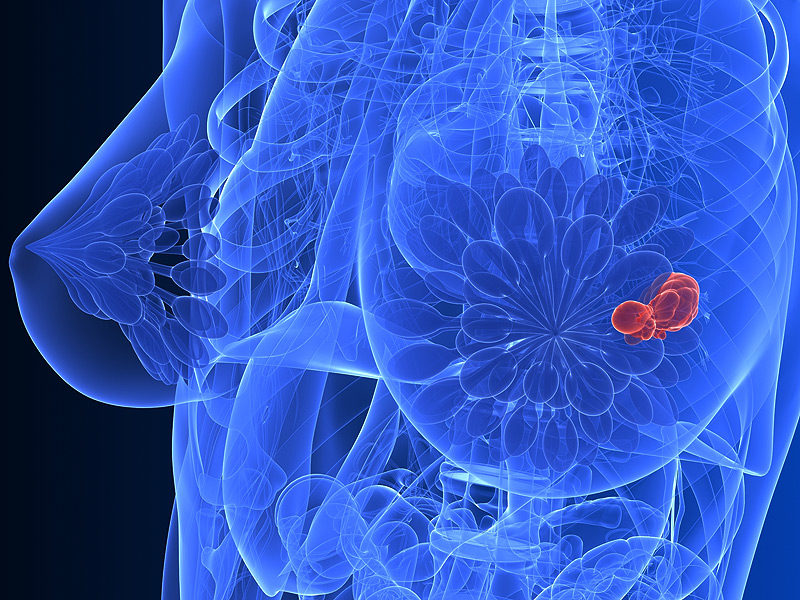Since then, other mutations linked with breast cancer have been discovered in genes including PALB2, CHEK2 and ATM.
These groundbreaking discoveries and subsequent research efforts mean women carrying the mutations are now offered personalised risk assessment, targeted treatment regimens and informed decision-making about managing their cancer risk.
Comment: And they'll still be offered the same miserable choices of chemo, surgery and radiation despite these groundbreaking discoveries.
But these discoveries only assist a minority of families with high rates of the disease.
For the remaining families, genetic studies have been unable to explain their multiple breast cancer cases. Our team's research, published in Nature Communications, helps fill in these blanks.
Using new technology, and working with 210 people from 25 multiple-case breast cancer families, we have new information about why some families who have no known genetic predisposition to breast cancer still experience multiple cases.
Comment: It's not all in the genes. Dietary and environmental toxins are the elephants in the room when it comes to cancer.
- Sugar and fructose intake in typical Western diet increases risk of breast cancer and metastasis to lungs
- Experts: Research fails to address environmental factors in breast cancer causes
It's all about epigenetics
Epigenetics, the study of the environment surrounding our genes and the regulation of their behaviour, is an exciting new field for researchers. It is providing insights into everything from evolutionary biology to cancer research.
We found that a proportion of the missing heritability of breast cancer is due to "epimutations" passed down through generations.
These are changes in an epigenetic mechanism called DNA methylation, which chemically modifies DNA without changing its sequence. This process is part of normal cellular regulation and is a mechanism that enables genes to be turned 'on' or 'off'.
DNA methylation can be passed from parents to children, and we found many instances of this that can predispose a family to breast cancer.
Building on existing knowledge
There were two important pieces of information that inspired our study. Small studies of known breast cancer susceptibility genes had found that DNA methylation, similar to genetic mutation, was also associated with increased risk of breast cancer.
The first piece of information came from careful analysis of the BRCA1 gene.
We found that DNA methylation measured in a blood sample at BRCA1 was associated with an estimated 3.5-fold increased risk of breast cancer before the age of 40.
The histological features (how the tumour cells looked down the microscope) of the breast cancers that developed in these women were indistinguishable from cancers that develop in women who carry BRCA1 genetic mutations, helping demonstrate that DNA methylation could mimic genetic mutation and predispose to breast cancer.
Comment: Diet and environment can turn genes on and off. See comment above.
The second piece of information came from studies of ATM, another gene where some genetic variation is associated with increased risk of breast cancer (for some ATM variants this risk of substantial). Two studies found evidence that changes in methylation at ATM was associated with up to 3-fold increased risk of breast cancer.
However, none of this work had been conducted on a genome-wide scale or outside known breast cancer susceptibility genes.
We were previously restricted by technology that only measured DNA methylation at specific and previously identified genes. With advancing technology, methylation can now be measured simultaneously across the entire human genome.
AN INNOVATIVE APPROACH
Working with participants in the Australian Breast Cancer Family Registry and the Kathleen Cuningham Foundation Consortium for Research into Familial Breast Cancer, we measured methylation at over 450,000 positions across the genome. These families represented those who were at risk but not carrying a mutation at known breast cancer genes.
We then used a new statistical method to systematically search the genome for heritable methylation marks associated with breast cancer risk.
This innovative approach enabled us to pinpoint heritable methylation marks associated with hereditary breast cancer - a method not possible in the context of genetic variation because all genetic variation is heritable.
We found 24 heritable methylation marks associated with breast cancer risk in Australian multiple-case breast cancer families. Four of these were also associated with risk of breast cancer in the Australian general population, suggesting they are relatively common.
This finding is paradigm shifting for current clinical genetic testing and it explains an additional proportion of the currently unexplained multiple-case breast cancer families.
The future
This work is the beginning of a new area of exploration for disease susceptibility.
For breast cancer, it means we can improve prediction for all women and better identify those at highest risk, develop new strategies for cancer control (including screening), new treatments using epigenetic therapeutics, and realise precision medicine.
Comment: Screening (mammograms) is not cancer control. It's a patient recruitment tool and it increases breast cancer risk to boot.
- Breast Cancer Risk Can Be Lowered by Avoiding Unnecessary Medical Imaging
- Why mammography is unscientific and harmful
- New study: Breast Cancer Deaths Lower in Areas Without Mammograms
More generally, it paves the way for similar studies in other disease settings where lifestyle and genetic risk factors do not explain all of the familial risk.




Reader Comments
to our Newsletter